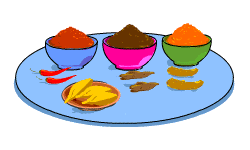The home of spices! Not for nothing is India known by this epithet as over 50 of the widely-known spices and other countless ones are grown here. From ancient times onwards, sailing ships carried Indian spices to the Middle East and Europe. It was the lure of spices that brought western explorers like Vasco da Gama to India. The preservative action of spices lured westerners to set sail for India; they could preserve meat by pickling it with cloves, wood smoke, mineral salts, mustard seed and ground mustard.
The characteristics of the numerous regional styles of cooking in India, writes well known nutritionist K.T. Achaya in Everyday Indian Processed Foods, lie very little in the basic food materials, whether rice, wheat, pulses or vegetables. Rather it’s the unique spices to be found in each region, in each community and in each home that give each dish its distinctive character.
What makes the Bengali fish curry redolent of mustard so different from the southern turmeric-flavoured tuvar dal sambhar. Spices give personality to the dish they’re added in; Indian cooking would indeed be dull and colourless without the right spices to enhance the flavour of the vegetables or meat or fish being cooked.

Spices of Life [Illustration by Shinod AP]
Asafoetida (hing) – Hing is the light-coloured, water-soluble root derived from a tree, mostly imported from Iran and Afghanistan. Used as a sedative and in indigestion.
Cardamom (elaichi) – Fruit capsule that grows on long spikes that take off underground from the stem and shoot straight from the ground. Used to relieve sore throat and to sweeten breath.
Chillies and Capsicum (mirch, molaga) – Fruits of several varieties of the family Capsicum annum that yield pungent red chillies, green chillies and mild bell peppers. Chillies, which originated in America, spread to the rest of the world including India in the 17th century by the Portuguese. Used to spice up food and fights indigestion.
Cinnamon bark (dalchini) – Bark of several species of true cinnamon and cassia trees. Washed, dried and sometimes fermented for two days. Used to check nausea, vomiting and diarrhoea.
Cinnamon leaves (tejpata) – Obtained from a species of cinnamon tree, sun-dried, then packed in bundles. Used to mildly flavour food.
Clove (lavang) – Unopened flower bud of a tree 10 metres tall, picked green, sun-dried to a dark colour. Name derived from its resemblance to a nail. A favourite toothache remedy, clove is also used against nausea, indigestion and gas.
Coriander seeds (dhaniya) – Seeds lightly roasted, often powdered. Used as a mild diuretic.
Cumin (jeera) – Fruits dried to yellow-to-greyish brown seeds. Used in indigestion and diarrhoea.
Curry leaf (kari patha) – Leaves, used fresh or lightly dried as a flavourant.
Fenugreek (methi) – Dried ripe pod carrying 10 to 20 small hard oblong seeds. Given to rheumatic patients and to women after childbirth.
Garlic (lassan) – White underground bulbs, lifted and cured for a few days in the shade. Garlic oil is applied in skin wounds and to cure earache.
Ginger (adrak) – Sun-dried adrak, peeled or unpeeled. Used in indigestion and against gas.
Mint (pudina) – Fresh leaves, used to make chutneys and sauces. There are at least 40 species of mentha, of which three are important in India. Used to cure digestive problems.
Mustard (sarson) – A small round reddish-brown or purple-black oilseed, four varieties of which are common: yellow sarson, oilseed, toria and rai. Used both in cooking and as a source of a pungent cooking oil popular in Bengal and Punjab. Rai is a good emetic or vomiting agent against poisons.
Pepper (kali mirch) – Sun-dried unripe berry growing on the spikes of a climbing vine. Used for afflictions of the throat and respiratory tract.
Turmeric (haldi) – Dried, boiled and polished rhizome or swollen underground stem. Used widely in cooking for its flavour and colour; has scores of other uses. It is a mild laxative; used to relieve discharges from the nose and eyes, and against sore throat.










